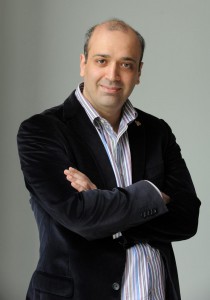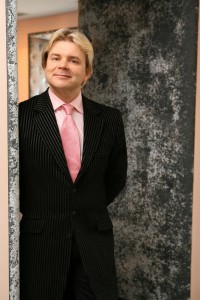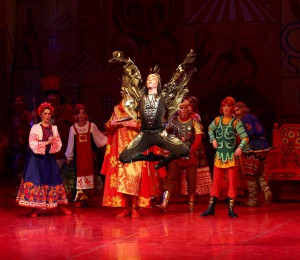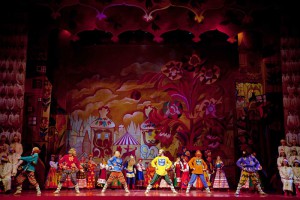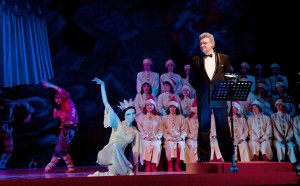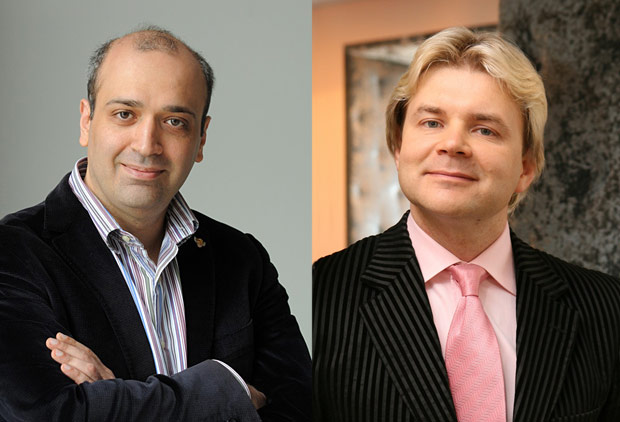
The former Bolshoi star, Andris Liepa, 52, returns to the London Coliseum from 8th to 19th July with a two-week programme in his itinerant series of Les Saisons Russes du XX1e Siècle. This will feature a triple bill of Liepa’s productions of Petrushka, Chopiniana and the Polovtsian Dances (from Borodin’s opera, Prince Igor) on 11th/12th July, followed by seven performances of Swan Lake (in the choreography of Lev Ivanov and Alexander Gorsky) from 15th to 19th July. There will also be a special gala celebrating the work of Sergei Diaghilev at 3pm on Sunday, 13th July.
The season opens with a production of Rimsky-Korsakov’s The Golden Cockerel (Le Coq d’Or), which is presented as an opera/ballet, as performed by Les Ballets Russes at the Paris Opéra in 1914, with designs by Natalia Goncharova and choreography by Mikhail Fokine (the last work that he made for Diaghilev). This revival of Le Coq d’Or is co-directed by Liepa and Georgy Isaakyan, 46, the celebrated opera director, now artistic director of the Natalia Sats Moscow State Opera and Ballet Theatre, which is the company that will perform at the Coliseum. Since almost all of Fokine’s choreography has been lost, Gali Abaidulov has been commissioned to choreograph the work in the style of Fokine.
Regular DanceTabs contributor, Graham Watts, visited the Natalia Sats Theatre in Moscow, earlier this year, to talk to both Liepa and Isaakyan about this new production of Le Coq d’Or.
The Natalia Sats Theatre is a remarkable institution that commemorates an extraordinary woman. The daughter of a composer who was a friend of Tolstoy, Sats devoted her life to establishing and developing grown-up theatres for children, a vocation that was interrupted only by the five years she spent in a Siberian Gulag (her crime, apparently, being to love a Red Army leader who was purged by Stalin). On her release, Sats was exiled to Kazakhstan where she established a new theatre for children in what is now Almaty. Following Stalin’s death, in 1953, she was finally allowed to return to Moscow.
“She was an amazing woman”, says Georgy Isaakyan, an Armenian who recently came to be artistic director of the Natalia Sats State Theatre after two successful decades as, firstly, opera director and then (from 1996) artistic director at the Perm State Opera and Ballet Theatre. “She had been the first woman to direct an opera on a European stage,” he continues, adding: “she was acclaimed as the favoured director of Otto Klemperer and commissioned Prokofiev to write Peter and the Wolf.”
Georgy Isaakyan.
© Georgy Isaakyan.
I am meeting both Isaakyan and Andris Liepa, the charismatic former Bolshoi dancer who now heads up the itinerant production series that travels under the brand of Les Saisons Russes du XX1e Siècle, in Sats’ “memorial office”. Her books, papers, countless awards and office furniture are still maintained in situ as a permanent shrine to the woman who turned up to see Leonid Brezhnev (then leader of the Soviet Union) with a pillow under her arm. Legend has it that she threatened to sleep in his office until the papers were signed to build a new children’s theatre in Moscow. “She wasn’t afraid to talk frankly to party leaders”, Isaakyan says. Brezhnev must have agreed; the papers were signed; and the 50th anniversary of the Natalia Sats Musical Theatre for Children will be celebrated in 2015. Sats died in 1993 but her daughter, Roksana (now 88) continues her work and is expected to be in London for these performances.
The Natalia Sats Theatre has been an essential impetus for enabling the project to “revive” Le Coq d’Or. “This company was unique in having all the resources I needed”, confirms Liepa. As an award-winning opera director, Isaakyan’s enthusiasm was obvious but there was a more pragmatic appeal. “Programming for this theatre has to be sophisticated”, he tells me. “It’s a children’s theatre but we don’t expect parents to switch off their brains for two hours while they sit with their kids”. On the day that we are speaking, the theatre has hosted two performances of Le Coq d’Or to capacity audiences and Liepa explains the significance of this: “Today, 3,000 people – children and parents – have come to see one of the most important productions of the Diaghilev era – what could be better education”?
“I knew this great production only by books”, Liepa continues: “And I have long dreamt about how this opera and ballet could be brought back to the stage in Goncharova’s designs. And now, thanks to Georgy’s commitment, we can see it as it was”. Liepa is at pains to stress the collaborative nature of the project:“We are co-directors – there is no priority as to who is number one – we made it together and we made it as big as possible and as beautiful as possible”, he says.
Le Coq d’Or is both fairy tale and allegorical satire. The central figure of Tsar Dodon is a weak and tired ruler, with two dim-witted sons fighting to be the more loved. When their lands are threatened from the east, the Tsar turns to an astrologer (we might describe him as a fortune teller or magician) to advise him what to do. The astrologer gives the Tsar a golden cockerel, which has magical powers to predict events, and he asks Dodon to promise to give him anything in return at any time in the future. The Tsar agrees. In due course, the golden cockerel warns that enemies are mobilising and the Tsar sends his two sons at the head of an “army” to make a pre-emptive strike. “But”, says Liepa, “there was no army – it is all fake. They are so stupid they think they can win a war without weapons”.
Pavel Okunev (Golden Cockerel) in The Golden Cockerel (Le Coq d’Or).
When the Golden Cockerel appears again, it warns the Tsar that his country is about to be “possessed”. The Tsar discovers that both his sons have been killed and he encounters the beautiful Queen of Shemakha, whom – even as an old man – he instantly desires. “He just goes nuts when he sees this beautiful Tsarina”, says Liepa. He promises her everything and they return to the capital to get married. “It is very important to remember that she is from the East”, interjects Isaakyan. But, as the Tsar announces their betrothal in the city square, the astrologer returns to remind the Tsar of his promise. He asks for the queen. “The Tsar goes mad”, says Liepa, enthusiastically getting into the role of storyteller, “and forgetting his own age, he says ‘you have grey hairs, you are old, what do you want with this beauty’”! In his rage, he accidentally kills the astrologer, and, Liepa continues: “…in that moment, everything unwinds. The golden cockerel flies down and kills the Tsar and the people are totally lost. They don’t know what to do. ‘How can we live without the Tsar’, they cry”.
In 1905, Tsar Nicholas II had survived a revolution and Russia had been defeated in an 18-month war with Japan, characterised by a false sense of superiority and military inefficiency leading to significant errors of judgement by the Tsar. In this context, Rimsky-Korsakov’s use of Pushkin’s poem (written in 1834) was, says Liepa with a certain degree of understatement, “…politically uncomfortable”. The opera was finished in 1907 but Rimsky-Korsakov never lived to see it performed (it premiered in Moscow, in 1909). “It sounds like a fairy tale”, says Liepa, “but 100 years ago it was a parody about the Tsar – his army didn’t exist, people around him were stupid and he wants to go to war but he has no weapons to fight. When he sees a beautiful girl he wants her and – on top of it all – this evil comes from the east”.
Les Saisons Russes in The Golden Cockerel (Le Coq d’Or).
©Elena Lapina
The main change to the production has been to create a role for Diaghilev. “It starts with a little bow to Mr Diaghilev when “he” comes out and begins the story”, explains Liepa. “Then at the end, Diaghilev returns and closes the curtain, saying that the story is unfinished: the Tsar is dead but the people are left not knowing what to do. In his final words, Diaghilev tells the people that they should decide for themselves what to do”. Liepa and Isaakyan explain that they initially considered representing Diaghilev as another opera singer but decided instead to make him a master of ceremonies.
Diaghilev’s production of Le Coq d’Or as an opera-ballet was premiered at the Paris Opéra in 1914. “It was only performed there because the stage was big and Diaghilev found the finances to bring the full company with opera, ballet and orchestra”, says Liepa. Diaghilev realised, however, that he could not tour with that many people and so it reverted to just the ballet for subsequent performances, continuing into the de Basil era of the 1930s. The Russian Seasons’ production premiered last year and has already returned to Paris but it will come to the Coliseum (a regular venue for Les Ballets Russes in London) to celebrate the centenary of the premiere.
The unique aspect of this production is the total fusion of opera and ballet. “Of course, we have ballet pieces in some operas”, says Liepa. “But, at most, this might be 30 minutes of a dance divertissement. We have never seen ballet and opera together, simultaneously, throughout the full work. And, there is no conflict of interests between opera singing and ballet dancing, from the beginning until the end. This is unprecedented”.
Isaaksyan adds the opera perspective. “It was crucial how the ballet looks through the opera singers because they are a kind of downstage lens. There is this formal, abstract opera world and folk-looking ballet world and I was afraid that it would be conflicting. In the Goncharova sketches you don’t see the opera – only the ballet dancers – and until the very last moment, we have been worried about how these two conflicting worlds would exist simultaneously. But, I have to say, that it looks fantastic because the static opera singers downstage provide a parallel world and sometimes keeps our attention on them – which is strange – rather than the dancers. It’s a funny effect but it gives a fresh feeling about what is the nature of opera and ballet”.
The one thing that is missing is Fokine’s original choreography, only four minutes of which survive on an Australian Ballet film from 1947. The full production is over two hours long so this surviving section was no more than an indicator of style. “There is no written text”, explains Liepa. “We have some idea from pictures of the original production, which we have been able to look at carefully. We also got inspiration from the Australian film and some ideas from other Fokine ballets in terms of his lines and the combinations of movement”.
Liepa has worked with Fokine choreography for more than 30 years and his father (Maris) began a Fokine legacy process as far back as 1966 when he restaged (and danced) Le Spectre de la Rose. “I would confidently say that I am an expert in Fokine’s choreography”, says Andris, adding, “we have already remade productions that no longer existed, like Tamar, Le Dieu bleu and Le Pavillon d’Armide, bringing back to life the original sets and costumes with our best understanding of the choreographic style.”
Natalia Sovelieva (Queen of Shemakha) and Oleg Fomin (King Dodon) in The Golden Cockerel(Le Coq d’Or).
©Elena Lapina
For Le Coq d’Or, Liepa and Isaakyan turned to Gali Abaidulov to develop the choreography. “He had worked with Georgy in Perm”, says Liepa, “and I knew him from my childhood because he was part of the great St Petersburg Ballet School”. “This ballet is unique”, he adds, “because it cannot just be ballet steps; it’s opera that is supposed to be projected in ballet; pantomime with choreography”.
“It is a reconstruction from a distance of 100 years and so we have also brought in a little bit of the point of view from today”, explains Liepa. Isaakyan chips in with: “…we are not pretending that this is reconstruction or revival of the choreography; but the set and costume design is totally reconstructed one-to-one. Viacheslav Okunev has researched the matter thoroughly, comparing the different versions of Goncharova’s designs because these changed over time: you can see the same picture in different colours, for example, because the set sometimes altered from theatre to theatre. The same is true of the costumes”,he continues, “where, for example, there were 3 or 4 different sketches for the astrologer’s outfit and so we had to decide on which to adopt for our production. The image of the golden cockerel on the famous Goncharova poster was never adapted as a costume for the stage, because it would have been impossible to dance in it. On the Australian tape you see a totally different costume for the golden cockerel. So, I would say that visually, it is certainly a reconstruction: but choreographically it is an homage to Fokine…..an interpretation….a celebration”.
Natalia Sovelieva (Queen of Shemakha), Alexandr Tsilinko (King Dodon),
in The Golden Cockerel(Le Coq d’Or).
©Elena Lapina
Apart from the addition of a Diaghilev character to narrate the story, the biggest difference between this and Fokine’s production is that his golden cockerel was danced by a woman. Liepa explains this: “…at that time, ballerinas could play the Coq d’Or much better than male dancers: they were smaller than boys and excellent technicians and so it worked as a girl”. He recalls that Tatiana Riabouchinska was one of the best golden cockerels when Fokine returned to set the work for the de Basil Company, in 1937. “But, in Russian tradition, the Coq d’Or is male”, he asserts, “and so, since we have incredible small boys in this company who are great jumpers, we decided that it was much better to cast boys”.
As our conversation winds to a close, Isaakyan is keen to bring the focus back to Diaghilev. “For me, it was so important to dedicate this work to Diaghilev. I worked for 20 years in Perm, which is Diaghilev’s city, where I established the International Diaghilev Festival, bringing companies from around the world to perform the work that he commissioned. And, so this was a very personal project for me, a chance to speak about my favourite art person, which is why you will see on stage this special reference to Diaghilev”. As we leave, Liepa expands this point: “…armed with a lot of knowledge, we have made our own tribute to Diaghilev; to Fokine; to Natalia Goncharova; and – of course – to Rimsky-Korsakov. It is all about their legacy and if our work inspires one child to be the next great arts entrepreneur, choreographer, designer or composer, then it will have been worthwhile”.
By Graham WattsPhotos by Elena Lapina
June 8, 2014

